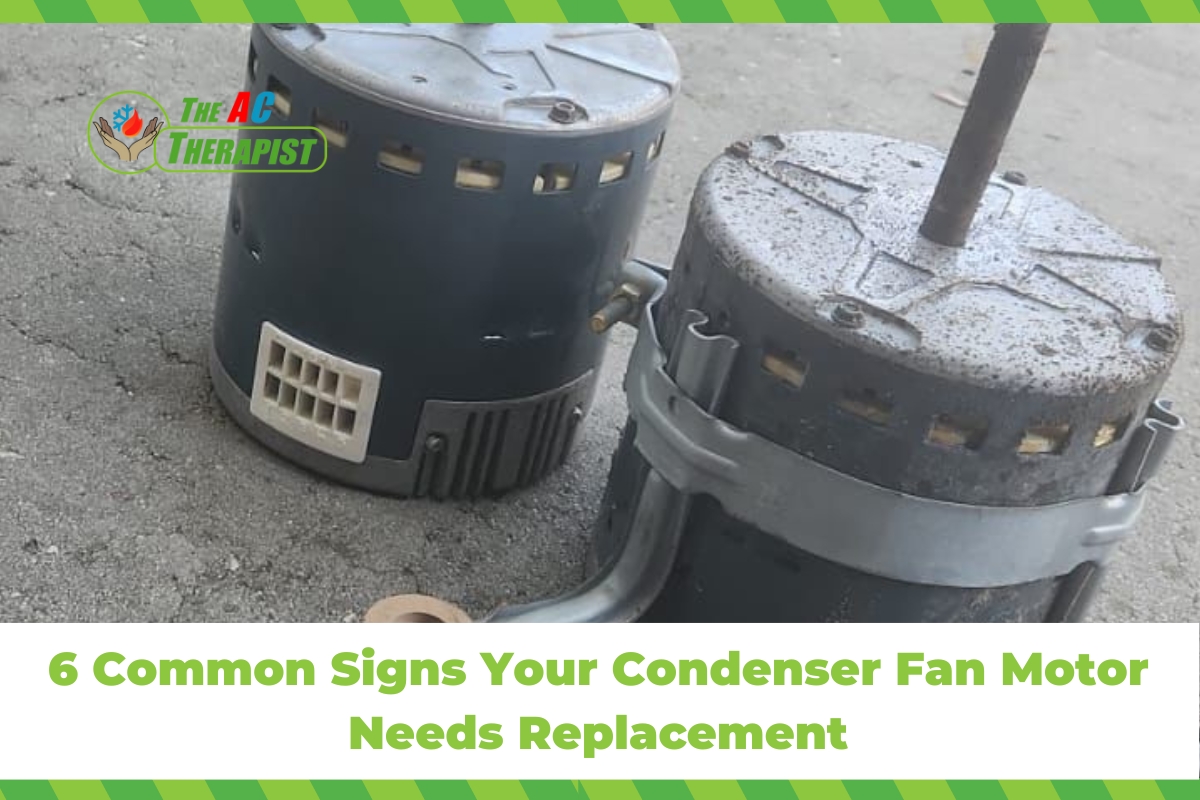6 Common Signs Your Condenser Fan Motor Needs Replacement
When it comes to your HVAC (Heating, Ventilation, and Air Conditioning) system, there are several components that work in harmony to keep your home comfortable throughout the year. One of these critical components is the condenser fan motor. While it may not be the most talked-about part of your HVAC system, it plays a pivotal role in its overall functionality and efficiency.
In this comprehensive guide, we’ll delve deep into the world of condenser fan motors, exploring what they are, how they work, why they’re essential, signs of problems, maintenance tips, and much more. By the end of this article, you’ll have a thorough understanding of the condenser fan motor and its importance in keeping your home comfortable.
What Is a Condenser Fan Motor?
Let’s start with the basics. What exactly is a condenser fan motor?
A condenser fan motor is a crucial component in an HVAC (Heating, Ventilation, and Air Conditioning) system, like the ones your company, The AC Therapist, deals with in the Tampa Bay area. It is typically found in the outdoor unit of a split air conditioning system or heat pump. The main function of the condenser fan motor is to dissipate heat from the refrigerant in the system.
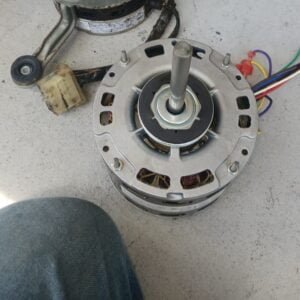
How Does a Condenser Fan Motor Work?
Understanding the inner workings of the condenser fan motor is essential to appreciate its significance. Here’s a simplified explanation of how it operates:
- Heat Dissipation: When your HVAC system is cooling your home, the indoor unit absorbs heat from inside and transfers it to the outdoor unit. In the outdoor unit, the condenser coil contains hot, high-pressure refrigerant gas. The condenser fan motor is responsible for creating airflow over these coils.
- Airflow: The fan motor’s blades draw in outdoor air and blow it over the condenser coils. As air passes over the coils, it absorbs the heat from the refrigerant inside. This process facilitates the release of heat from the refrigerant, causing it to condense into a high-pressure liquid.
- Temperature Regulation: The speed at which the condenser fan motor operates is regulated based on several factors, including outdoor temperature and the HVAC system’s cooling needs. If it’s a hot day, the fan may run at a higher speed to maintain proper cooling.
In summary, the condenser fan motor plays a vital role in transferring heat from inside your home to the outside air, enabling the refrigerant to complete its cycle and providing the cooling effect you desire.
The Importance of the Condenser Fan Motor
Now that we understand how the condenser fan motor works, let’s delve into why it’s so important for your HVAC system:
1. Heat Dissipation
As mentioned earlier, the primary function of the condenser fan motor is to dissipate heat. Without this crucial step, the refrigerant in the system cannot release the heat it has absorbed from your home’s interior. This means that your HVAC system wouldn’t be able to provide cooling, which is its main purpose.
2. Energy Efficiency
An efficient condenser fan motor is essential for the overall energy efficiency of your HVAC system. When the motor operates optimally, it ensures that the system doesn’t overheat, reducing the risk of damage and helping your system run at its peak performance. This efficiency translates to energy savings and a lower electricity bill.
3. System Longevity
A well-maintained condenser fan motor can significantly extend the lifespan of your HVAC system. Regular maintenance and timely repairs or replacements, when needed, prevent strain on the entire system, reducing wear and tear and potentially saving you from costly repairs or replacements.
4. Consistent Cooling
To maintain a comfortable indoor environment, your HVAC system must provide consistent cooling. The condenser fan motor’s role in heat dissipation ensures that your system can achieve and maintain the desired temperature in your home.
5. Environmental Impact
Energy-efficient HVAC systems, including condenser fan motors, have a lower environmental impact. They consume less electricity, reducing greenhouse gas emissions and helping to minimize your carbon footprint.
Given these crucial roles, it’s clear that the condenser fan motor is a linchpin in the functionality of your HVAC system. Without it, your system would be unable to cool your home effectively, resulting in discomfort and potentially costly issues.
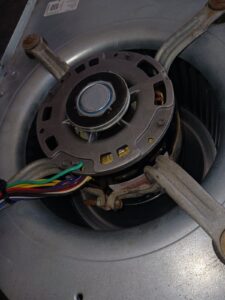
What happens when a condenser fan motor fails?
When a condenser fan motor fails, it can have several significant consequences for your HVAC (Heating, Ventilation, and Air Conditioning) system and your indoor comfort. Here’s what typically happens when a condenser fan motor fails:
- Reduced Cooling Capacity: The primary function of the condenser fan motor is to dissipate heat from the refrigerant in the system. When the fan motor fails, heat cannot be effectively released from the system. As a result, your HVAC system’s cooling capacity diminishes. This means your air conditioner will struggle to keep your home cool, and you may experience rising indoor temperatures.
- Overheating: A failing or non-operational condenser fan motor can cause the entire outdoor unit (condensing unit) to overheat. This can lead to safety features like thermal overload protection and shutting down the compressor to prevent damage. An overheated system can result in erratic cooling or no cooling at all.
- Increased Energy Consumption: To compensate for the lack of heat dissipation, your HVAC system may run continuously or for extended periods. This leads to higher energy consumption, which is reflected in increased utility bills.
- Potential Damage: The strain on the compressor caused by overheating can damage the compressor over time. Compressor replacement is a costly repair, and it might be necessary if the condenser fan motor issue isn’t addressed promptly.
- Compressor Failure: In severe cases, a failing condenser fan motor can lead to compressor failure. The compressor is one of the most expensive components in your HVAC system, and its replacement is a substantial expense.
- Reduced System Lifespan: Continuous operation under stressful conditions can significantly shorten the lifespan of your HVAC system. Regularly running the system with a failed condenser fan motor can lead to premature wear and tear on various components.
- Inefficient Operation: Even if the system continues to operate, it does so less efficiently. Reduced efficiency means not only higher energy bills but also a less environmentally friendly system, as it consumes more electricity.
- Noisy Operation: A malfunctioning fan motor may produce unusual noises, such as grinding or squealing sounds, which can be disruptive and annoying.
Given these potential consequences, it’s crucial to address a failing or failed condenser fan motor promptly. Ignoring the issue can lead to more extensive and costly repairs or replacements down the road. If you suspect that your condenser fan motor is experiencing problems, it’s advisable to contact a qualified HVAC technician or contractor to diagnose the issue and perform the necessary repairs or replacements to restore your HVAC system’s proper function.
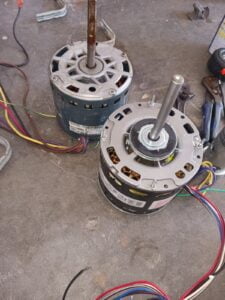
6 Signs of a Failing Condenser Fan Motor
Now that we’ve established the importance of the condenser fan motor, it’s vital to recognize when it’s experiencing issues. Here are some common signs that your condenser fan motor may be failing:
1. Irregular or No Operation
If the fan motor doesn’t start when your HVAC system does or runs intermittently, there could be an issue. This may lead to inconsistent cooling in your home.
2. Unusual Noises
Unusual noises like clicking, grinding, or squealing coming from the outdoor unit can indicate problems with the fan motor or other components in the system.
3. Reduced Cooling Capacity
If you notice that your HVAC system is not cooling your home as effectively as it used to, it may be due to a struggling condenser fan motor.
4. Overheating
A fan motor that’s working too hard may overheat. You might notice the motor itself is hot to the touch or that the motor shuts off due to thermal protection mechanisms.
5. High Energy Bills
A failing condenser fan motor can lead to increased energy consumption, resulting in higher electricity bills. If you see a sudden spike in your energy costs, it’s worth investigating your HVAC system.
6. Visual Damage
Inspect the fan motor for visible damage or wear and tear. Physical damage can be a clear indicator of a problem.
If you observe any of these signs, it’s crucial to address them promptly to prevent further damage to your HVAC system and ensure your home remains comfortable. Ignoring these issues can lead to more extensive and costly repairs down the road.
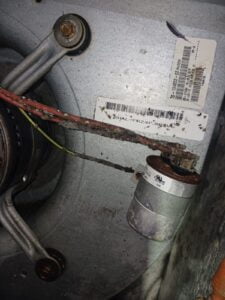
Replacing a Condenser Fan Motor
If your condenser fan motor is indeed failing or has reached the end of its lifespan, you may need to replace it. Here’s a step-by-step guide to replacing a condenser fan motor:
- Diagnosis: First, ensure that the problem is indeed with the condenser fan motor. Sometimes, issues may seem like motor problems but could be related to electrical issues or other components.
- Turn Off Power: Always turn off the power supply to the HVAC unit before attempting any repairs to ensure safety.
- Remove the Fan: Unmount the fan from the condenser unit. This typically involves removing screws and disconnecting electrical connections.
- Inspect and Test: Examine the motor for any visible damage or signs of wear and tear. You can also test the motor’s windings for continuity using a multimeter.
- Replacement: If the motor is faulty, it will need to be replaced. Make sure to get the correct replacement motor that matches the specifications of your HVAC system.
- Installation: Install the new motor in the same position as the old one, ensuring that it’s properly secured and aligned.
- Wiring: Reconnect the electrical wires according to the manufacturer’s instructions. Double-check your connections to ensure they are correct.
- Testing: Turn the power back on and test the HVAC system to ensure that the condenser fan motor is functioning properly.
- Maintenance: Regular maintenance of your HVAC system can help prevent issues like this in the future. Consider offering your Therapy Maintenance Plans to your customers to keep their systems running efficiently.
Remember that HVAC repairs can sometimes be complex, and if you’re not experienced in this field, it’s best to recommend professional help to ensure the job is done safely and effectively.
How much does it cost to replace the condenser fan motor?
The cost to replace a condenser fan motor can vary widely depending on several factors:
- Motor Type and Brand: The cost can differ based on the type and brand of the motor. High-efficiency or specialized motors may be more expensive.
- Motor Size: Larger motors generally cost more than smaller ones, and the size required depends on your HVAC system’s specifications.
- Labor Costs: Labor charges vary by location and the complexity of the installation. A straightforward replacement may cost less than a more complex installation.
- Additional Repairs: If other components in your HVAC system require attention or replacement, this can add to the overall cost.
- Warranty: Some motors come with warranties that cover part or all of the replacement cost, which can affect your expenses.
- Professional vs. DIY: Hiring a professional HVAC technician will typically incur labor costs but ensures proper installation. Attempting a DIY replacement can save on labor but carries the risk of mistakes and potential damage to the system.
Maintaining Your Condenser Fan Motor
Preventive maintenance is key to keeping your condenser fan motor and your entire HVAC system in top shape. Here are some maintenance tips to help you achieve that:
Regular Cleaning
Dust, debris, and dirt can accumulate on the condenser coils and the fan motor itself, reducing efficiency. Periodically clean the outdoor unit, including the coils and fan blades, to remove any obstructions.
Lubrication
Some fan motors require lubrication to operate smoothly. Check your system’s manual for guidance on lubricating the motor, and ensure you use the recommended lubricant.
Visual Inspection
Regularly inspect the fan motor for visible damage, corrosion, or loose connections. Address any issues promptly to prevent further damage.
Professional Maintenance
Consider scheduling annual professional maintenance for your HVAC system. A technician can perform a thorough inspection, cleaning, and tune-up, ensuring that all components, including the condenser fan motor, are in excellent condition.
Clear Surroundings
Ensure that the area around your outdoor unit is free from obstructions. Trim vegetation and remove debris to maintain proper airflow.
Upgrading to a High-Efficiency Condenser Fan Motor
Modern advancements in HVAC technology have led to the development of high-efficiency condenser fan motors. These motors are designed to operate more efficiently, resulting in energy savings and reduced environmental impact.
Here are some benefits of upgrading to a high-efficiency condenser fan motor:
- Energy Savings: High-efficiency motors consume less electricity, leading to lower energy bills over time.
- Quieter Operation: These motors often run more quietly, reducing noise levels during operation.
- Improved Comfort: A high-efficiency motor can help your HVAC system maintain consistent temperatures, enhancing your overall comfort.
- Environmental Benefits: Lower energy consumption contributes to reduced greenhouse gas emissions, making your home more environmentally friendly.
When considering an upgrade, consult with an HVAC professional who can recommend the best motor for your system and ensure a proper installation.
Condenser Fan Motor Brands and Models
Now that you understand the importance of the condenser fan motor and how to maintain it let’s explore some reputable brands and models in the market. Keep in mind that the availability of specific brands and models may vary depending on your location and the HVAC contractor you work with.
1. Carrier
Carrier is a well-known name in the HVAC industry and offers a range of high-quality condenser fan motors. Their products are known for their durability and performance.
2. Trane
Trane is another reputable brand with a long history of providing reliable HVAC components. They offer a variety of fan motors designed to work seamlessly with their systems.
3. Lennox
Lennox offers condenser fan motors that are engineered for efficiency and longevity. Their products are often compatible with a wide range of HVAC systems.
4. Rheem
Rheem is known for its energy-efficient HVAC components, including condenser fan motors. They prioritize innovation and performance in their products.
5. Emerson
Emerson is a trusted name in HVAC motors. They offer a range of condenser fan motors designed for various applications and system types.
It’s essential to consult with your HVAC contractor or technician when selecting a replacement motor to ensure compatibility with your specific system. They can recommend the best options based on your needs and budget.
In conclusion, the condenser fan motor may not be the most prominent component in your HVAC system, but its role in heat dissipation and system efficiency is undeniably crucial. Understanding how it works, its importance, and how to identify and address issues with it can help you maintain a comfortable home environment while optimizing energy usage and minimizing repair costs.
Regular maintenance, including cleaning and inspection, is vital for the longevity and performance of your condenser fan motor. Additionally, considering an upgrade to a high-efficiency motor can lead to long-term energy savings and environmental benefits.
Remember that HVAC system maintenance and repair, especially those involving critical components like the condenser fan motor, are best handled by qualified professionals. If you suspect any issues with your HVAC system or its components, don’t hesitate to contact a reputable HVAC technician to assess and address the problem promptly. By doing so, you can ensure that your HVAC system continues to provide reliable and efficient cooling and heating for your home.
Ensuring HVAC Excellence: The Significance of Condenser Fan Motor Maintenance and Replacement with The AC Therapist
In conclusion, the condenser fan motor stands as a pivotal component within the intricate machinery of your HVAC system. Its significance lies in its ability to facilitate the dissipation of heat, a fundamental process in the cooling and heating of your home. Understanding the importance of this unassuming yet indispensable part is crucial for homeowners and business owners alike.
Regular maintenance and the timely replacement of the condenser fan motor are imperative for the sustained efficiency and longevity of your HVAC system. Neglecting its upkeep can result in a range of issues, from reduced cooling capacity and increased energy consumption to potential system failures.
That’s where The AC Therapist, your local residential and light commercial HVAC contractor in the Tampa Bay area, comes into play. Their expertise in air conditioning services, including condenser fan motor maintenance and replacement, ensures that your HVAC system operates at peak performance. With their Therapy Maintenance Plans, you can enjoy peace of mind, knowing that your system is in capable hands.
Whether it’s a simple maintenance visit or a complete replacement, The AC Therapist’s commitment to excellence and dedication to customer satisfaction make them the go-to choice for all your HVAC needs. Trust in their experience and knowledge to provide you with a comfortable and well-maintained indoor environment, ensuring that your home or business remains a haven of comfort throughout the seasons. Don’t hesitate to reach out to The AC Therapist for all your condenser fan motor needs and HVAC services.

